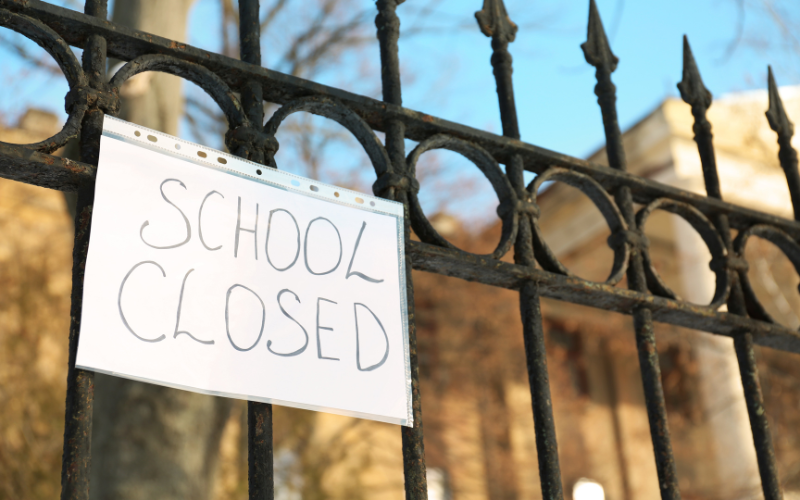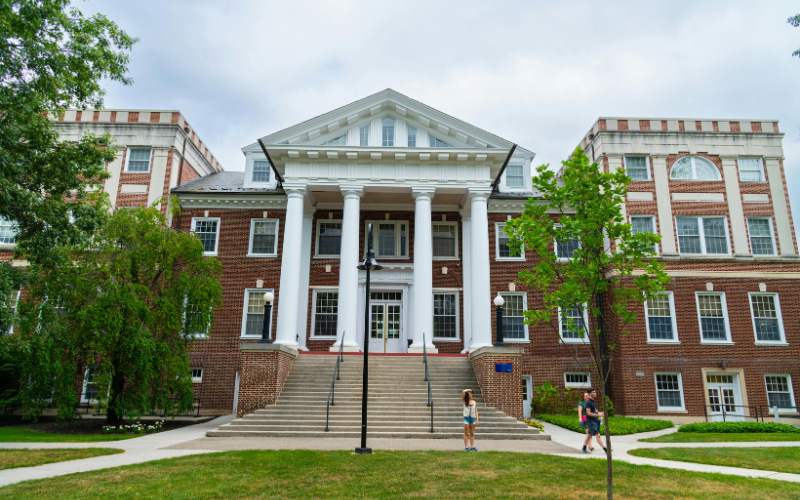The ongoing news about higher education institutional finances is not good. Every week, there is a new report about an institution closing its doors or merging with another institution. State budgets are experiencing more pressure as the federal government’s COVID funding disappears, and the funding cuts usually impact higher ed.
I wanted to review recent news about private and public college closures, mergers, and budget cuts published in the past six weeks. Some of these announcements are follow-ups from earlier announcements. It’s likely that I’ve missed a few, so I make no claims that this is all-inclusive. I don’t believe the pace of announcements will slow anytime soon.
Union Institute & University Announces Closure
A few days after surrendering its accreditation, Union Institute & University announced it is closing at the end of June 2024. The Cincinnati-based institution last offered undergraduate and doctoral classes in the summer and fall of 2023. In November 2023, the university lost access to federal student aid funding.
Penn State Faculty Question Regional Leadership Model
Penn State announced a plan to modernize its business model in January 2024. I wrote about the plan and noted that there were 20 Commonwealth campuses that had dramatically different enrollments than the main campus in College Station, as well as the Global online campus.
Inside Higher Ed’s Josh Moody reported that 383 employees at the 20 Commonwealth campuses participated in the voluntary separation incentive program (VSIP) recently offered to them. The buyouts and a restructuring that will combine 11 Commonwealth campuses into four regional groups will save $43 Penn State million annually.
Some Penn State faculty members complained that the process was rushed, with only three weeks to decide whether to participate in the VSIP announced in May. Some were also concerned about a single chancellor leading two or three campuses. Additionally, the buyouts were announced at the same time a $700 million renovation of the flagship’s football stadium was announced.
Arizona’s Legislature Cuts Millions from Public Universities

Arizona’s governor signed a bipartisan budget package in mid-June that will slash public university funding. Funding will be reduced by $11 million at Arizona State University, $6.6 million at the University of Arizona, and $4.1 million at Northern Arizona University.
The news is not good for the University of Arizona, struggling to reduce a projected $177 million deficit . UofA’s budget challenges led to the resignation of its CFO and, some months later, its president. Higher Ed Dive’s Ben Unglesbee reported that Arizona’s higher education funding is down 35% from 2008 levels. In a more recent article, Unglesbee wrote that UofA has reduced its projected deficit to $52 million through cuts.
It’s unlikely that Arizona’s situation will improve soon, as the state is working to close a $1.4 billion budget deficit.
New Jersey Community Colleges Face Funding Cut
Governor Phil Murphy’s fiscal 2024-2025 budget proposal will cut $20 million (or 12%) from the funding of its 18 community colleges. Governor Murphy stated that his budget provides the same level of funding as a year ago before the legislature allocated an additional $20 million to the colleges to cover healthcare expenses.
The president of the New Jersey Council of Community Colleges noted that New Jersey’s community colleges rank 46th among the 47 states with community colleges in terms of state support per full-time student. He hopes the legislature will restore the funding “cut” and colleges will avoid making cuts or increasing tuition next year.
Update: New Jersey’s lawmakers restored the $20 million community college funding cut in a last minute update before Governor Phil Murphy signed the budget Friday night.
Alverno College’s Board Declares Financial Exigency
The Board of Trustees at Alverno College recently voted to declare financial exigency. This step allows institutions in financial trouble to restructure academic programs and terminate faculty contracts.
Alverno announced that it would reduce the number of undergraduate programs from 43 to 29 and the number of graduate programs from 25 to 19. In addition, 25 full-time faculty positions and 12 full-time staff positions will be eliminated.
Alverno is based in Wisconsin. A spokesperson announced that they expect a $9 million deficit for the current academic year, its fifth in six years.
University of Wisconsin at Oshkosh to close Fox Cities Campus
The University of Wisconsin at Oshkosh announced it will close its Fox Cities campus effective June 30, 2025. The campus is approximately 20 miles from Oshkosh and is one of the two-year campuses transferred to UW’s four-year institutions. It will be the sixth two-year campus to close in the last few years.
The Chancellor of UW-Oshkosh noted that the Fox Cities campus’ enrollment declined by two-thirds over the past ten years. Enrollment projections indicate that if recent trends continue, total enrollment could fall below 100 by 2032.
University of Wisconsin at Oshkosh Depletes Its Reserves
In early June, the Milwaukee Journal Sentinel reported that the University of Wisconsin at Oshkosh spent all the discretionary money in its unrestricted reserves. The report quoted a UW Board of Regents member who said that despite deep job cuts last year, UW-Oshkosh is facing a $7.6 million deficit.
More than 250 jobs were cut through layoffs, retirements, and the elimination of vacant jobs. The University of Wisconsin System will tap into its reserves to cover the depleted balance at UW-Oshkosh. The university will repay the loan with interest. The Sentinel reported that six of the 13 UW system members expect deficits for the coming academic year.
Louisiana Colleges May Face $250 Million Budget Cut
Members of the Louisiana Board of Regents expressed concern about a budget shortfall if a state sales tax sunsets in the 2025-2026 fiscal year. The Board is responsible for 30 of the state’s higher education institutions. A loss of $250 million would be equivalent to a budget cut of 20%.
Cuts to public institutions could be particularly challenging if the botched U.S. Department of Education Free Application for Federal Student Aid (FAFSA) rollout impacts enrollments for the 2024-2025 academic year. During Gov. Jindal’s administration, state financing for higher education was cut by $700 million over five years. Public universities state they are still recovering from those cuts.
Pittsburgh Technical College to Close in August

The Board of Pittsburgh Technical College announced that the school would close in August. The reasons for the closure included declining enrollments, market pressures, inflation stemming from the COVID-19 pandemic, and changing views of higher education.
Last fall, five of the college’s seven trustees resigned after employees voted no-confidence in PTC’s president. The Middle States Commission on Higher Education put the college on probation in March. In early June, Middle States announced that the college was in danger of imminent closure.
Cal State System Recommends Merger of Two Institutions
Officials from the California State System recommended that California State University Maritime Academy and California Polytechnic State University, San Luis Obispo, combine operations, resources, and governance. If the merger is approved by the CSU Board, it will be completed at the start of the 2026-2027 academic year.
Enrollment at Cal Maritime has fallen from 1,100 students in the 2016-17 year to 750 in 2023-2024. Rising employment and operational costs have added to Cal Maritime’s financial deficits. The plan will provide a long-term solution to Cal Maritime’s “untenable fiscal circumstances,” CSU Chancellor Mildred Garcia wrote.
University of the Arts Announces Sudden Closure
The University of the Arts announced that it would close on June 7. The Philadelphia non-profit also announced that the Middle States Commission on Higher Education withdrew its accreditation the same day.
The university’s announcement was controversial given that its president and board chair were not specific about the reasons for closure and the non-transparent statement that it had encountered “significant, unanticipated expenses” on May 14.
The June 2, 2024, Inside Higher Ed article reporting the University of the Arts closing mentioned the following closures and mergers announced thus far in 2024:
- Delaware College of Art and Design, Delaware
- Oregon College of Oriental Medicine, Oregon
- Eastern Gateway Community College, Ohio
- Wells College, New York
- University of Saint Katherine, California
- Goddard College, Vermont
- Oak Point University, Illinois
- Birmingham-Southern College, Alabama (note: It was announced on June 24 that Miles College submitted a LOI to acquire the campus of Birmingham-Southern)
- University of Wisconsin at Milwaukee, Waukesha campus
- Bluffton University, Ohio
- Cambridge College, Massachusetts
- Fontbonne University, Missouri
- Notre Dame College, Ohio
- Jamestown Business College, New York
Marymount Manhattan College Merges with Northeastern University
In late May, Northeastern University announced it was expanding into New York City by merging with Marymount Manhattan College. Marymount will be the 14th campus added to the Northeastern Global University System. Inside Higher Ed’s Josh Moody reported that, unlike other mergers, Marymount’s finances appear to be stable from the outside.
Marymount leadership commented that small, tuition-dependent liberal arts colleges face strong headwinds, including declining enrollment, rising operating costs, and declining confidence in the return on investment of a college degree. They stated that the merger enables them to continue their mission for many years.
Concordia University Ann Arbor to Cut Most Programs
Concordia University Ann Arbor announced that it will cut dozens of on-campus and online programs. The Lutheran institution will offer just nine campus-based programs, all in the medical field, beginning June 2025. That’s a substantial decrease from the 53 it currently offers. Its online programs will be reduced to seven from 60. The school will teach out its online students and campus-based students can complete their programs at Concordia Wisconsin, nearly 360 miles away.
Bacone College Files for Bankruptcy
Inside Higher Ed’s Josh Moody reported that struggling Bacone College filed for bankruptcy last Friday. The college is known for its education of Native Americans and for a style of Native American art named for the college. The college’s interim president said the college will “take next year off” in hopes of finding a merger partner. Its enrollment this past fall was down to 100 students.
Eastern Nazarene College to Close
Higher Ed Dive’s Ben Unglesbee reported this week that Eastern Nazarene College’s Board of Trustees voted to close.The Massachusetts faith-based institution has experienced declining enrollments and increased operating deficits over the past years.
The college has signed teach-out agreements with three other faith-based institutions. The college’s goal is to finish teaching undergraduates and grad students who are on track to complete their programs at the end of the academic year 2024-2025.
Being able to continue to teach that specific group of students depends on a critical mass of faculty and students willing to remain at the college for one more year.
Hampshire College Cuts Nine Percent of Staff
Higher Ed Dive reported that Hampshire College is cutting nine percent of its staff as a response to lower than expected enrollments for the coming academic year. Hampshire’s president reported in an interview that the 29 employee positions will be cut, saving $2.7 million per year in expenses. Senior leaders at the college will also take a 13% cut in compensation.
Clark’s Summit University to Close
Baptist College Clark’s Summit University furloughed all its employees in June in an attempt to restructure and reopen in the Fall. This week, the university’s board announced that Clark’s Summit would close in August. Enrollment declines and budget deficits were cited as the primary reason for its permanent closure.
Northwestern College Closes Abruptly
For-profit and 122-year old Northwestern College closed on July 6. Higher Ed Dive’s Ben Unglesbee reported that the college had been on and off probation with its accreditor, the Higher Learning Commission. In addition, it had been on heightened cash monitoring with the Department of Education.
Western Illinois University Fires 36 Faculty
At the end of June, Western Illinois University opted not to renew the contracts for 36 associate faculty. The university announced that the cuts were made to assure financial stability. WIU is operating with an interim president with no plans to hire a new president until the university’s financial situation is stabilized.
Averett University Slashes Pay to Cover Deficit
Danville, VA-based Averett University cut faculty and staff pay 20 percent to make up for unauthorized withdrawals from its endowment. The cuts, which were announced as temporary, are to offset $6 million in funds transferred without authorization from the endowment to cover operating costs. Approximately 125 of the school’s 200 full-time employees are experiencing the cuts over a 9-week period. New hires are frozen and senior leadership is experiencing a higher percentage cut in pay in order to reduce the operating deficit.
FAFSA Fiasco Forces Cuts
Inside Higher Ed’s Liam Knox reported that the FAFSA fiasco forced small colleges to cut costs, some as they were rebounding from the Covid-19 crisis. Lindenwood University, Bradley University, and the University of Lynchburg are among the small colleges mentioned whose enrollment declines forced their leadership team to cut degrees and sports teams among other expenses.
A spokesperson for the National Association of Independent Colleges and Universities said that the FAFSA crisis was a “force multiplier” that expedited program cuts at small colleges whose finances were already straining from enrollment challenges.
Frostburg State University Announces Cuts
Higher Ed Dive’s Natalie Schwartz reported that Maryland’s Frostburg State University announced more than $7 million in cuts that will take place over several years. The cuts are designed to offset enrollment declines, the botched FAFSA rollout, and cuts in state budgeting. Frostburg, one of 12 members of the University of Maryland System, has experienced a 36% decline in enrollments since 2010.
A Few Thoughts
The pace of these announcements will not slow for several reasons.
- Additional funding provided to states because of the COVID-19 crisis is going away.
- The high cost of college has increased the percentage of Americans who question college’s return on investment.
- Most regions of the U.S. will experience a demographic cliff in 2026 when the number of high school graduates will decline.
- The FAFSA debacle, which affects students applying for financial aid, is estimated to impact fall 2024 enrollments by as much as 10%.
- Tuition-dependent private colleges have not decreased their tuition discounts with this past fall recording the highest discount percentage in history.
The purpose of this article is not to warn people of the pending closures. There were more than a few of those prognostications in 2020. That year, I wrote about the College Stress Test, the Financial Fitness Tracker, and the Galloway risk/rating system. All were designed to “predict” which colleges were at risk of closing.
Since 2020, a few other evaluation tools have surfaced. Sadly, many recent closures appear to be colleges that were not being monitored by the Department of Education or their accreditor. It’s well known that not all students continue their education when their institution closes. The leaders of institutions in danger of closing should consider their students first, as Marymount Manhattan College’s leadership team did.











